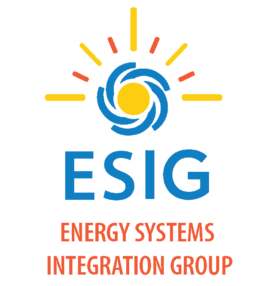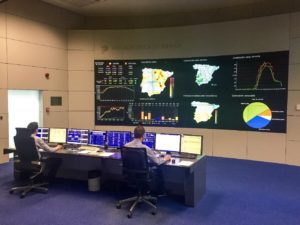The Control Center for Renewables (CECRE) was officially inaugurated in 2007 to supervise and, if necessary be able to control, renewable energy facilities larger than 10 MW in Spain. The purpose was to assure the integration of renewable energies in the Spanish peninsular system, maximizing their output, while maintaining the same high security of supply standards.
Ten years afterwards, in 2017, it receives real-time telemetry of all facilities larger than 1 MW, more than 2800 with a total installed capacity of 37 GW. It sends limits of maximum production to facilities larger than 5 MW, to around 1500 of the 2800 mentioned before, accounting for 33 GW.
However, the most significant evolution of the CECRE was implemented in 2016, as a new regulatory framework entered into force in the real-time management of Renewable Energy Sources (RES). From then on, RES were granted priority of dispatch over high efficiency Combined Heat and Power (CHP) or conventional generation, but only if it implied the same costs to solve congestions or keep the system in balance for the final consumers. Such change meant that, as was usual already for conventional generation, market parties representing RES in the Spanish electricity wholesale markets were obliged to send downward redispatching bids for all the energy that is scheduled on the market.
Downward bid prices are floored at 0 €/MWh, which would mean that the RES producer would not need to pay anything for changing its schedule downwards, and can keep all the money received for selling its forecasted power in the day-ahead or intraday wholesale markets. Some of the older facilities do not receive return of investment premiums anymore and are only paid the market price. If the newer ones are sure they will reach the minimum yearly equivalent full power hours to receive their corresponding return of investment premiums, some of them prefer to pay something to be powered down and avoid variable costs such as wear and tear or bidding costs. This means that there are normally a significant amount of downward bids at prices higher than 0 €/MWh.
For the CECRE algorithms in charge of determining which individual facilities were to be limited, and how much, to assure the solution of a constraint, including that of lack of downward reserve in the system, it meant changing the simple prorate based algorithm. This takes also into account the priorities of dispatch according to the technologies of the facilities.
Now, before applying such prorate, the different downward bids that can solve the constraint are organized in descending price order, assigning first those with the highest downward price. This means that REE is selling the energy necessary for the needed redispatch on behalf of the final customers and assigning those buying bids with the highest price first. The cost of the redispatch for the final customers is then the difference between the hourly market marginal price and the assigned bid price, multiplied by the amount of MWh redispatched. Bids are paid as bid.
If the downward bid price is the same for different facilities, then they will be ordered according to the priorities of dispatch of their technology. If these are also the same, they will be redispatched simultaneously using the same prorate algorithms as before.
Another substantial regulatory change for the running of CECRE, introduced simultaneously, is the participation of RES in the balancing markets. Any facility that wishes to participate must pass the same prequalification tests designed for all technologies, without the need to have the ability to provide its full capacity at any time. Participation by variable renewable generation is currently significant in the tertiary reserve upward and downward market, with more than 6700 MW of wind generation prequalified to participate and competing with conventional technologies. Such numbers are a significant milestone in achieving better integration of variable RES in the Spanish peninsular system. In the first three months of 2017, this has allowed all balancing needs of the system to be covered with units that participate in the balancing markets, without the need to use the CECRE as a last resort mechanism for system balancing.
In conclusion, the changes implemented in the CECRE in the last year have all aimed at treating variable RES not like a special technology anymore, but as one of the main technologies that make up the Spanish electricity mix. In fact, it was about time, since in 2013 wind was already and for the first time the technology with the most energy delivered to the Spanish electrical system.
Miguel de la Torre Rodríguez
Red Eléctrica de España SAU


Leave a Reply